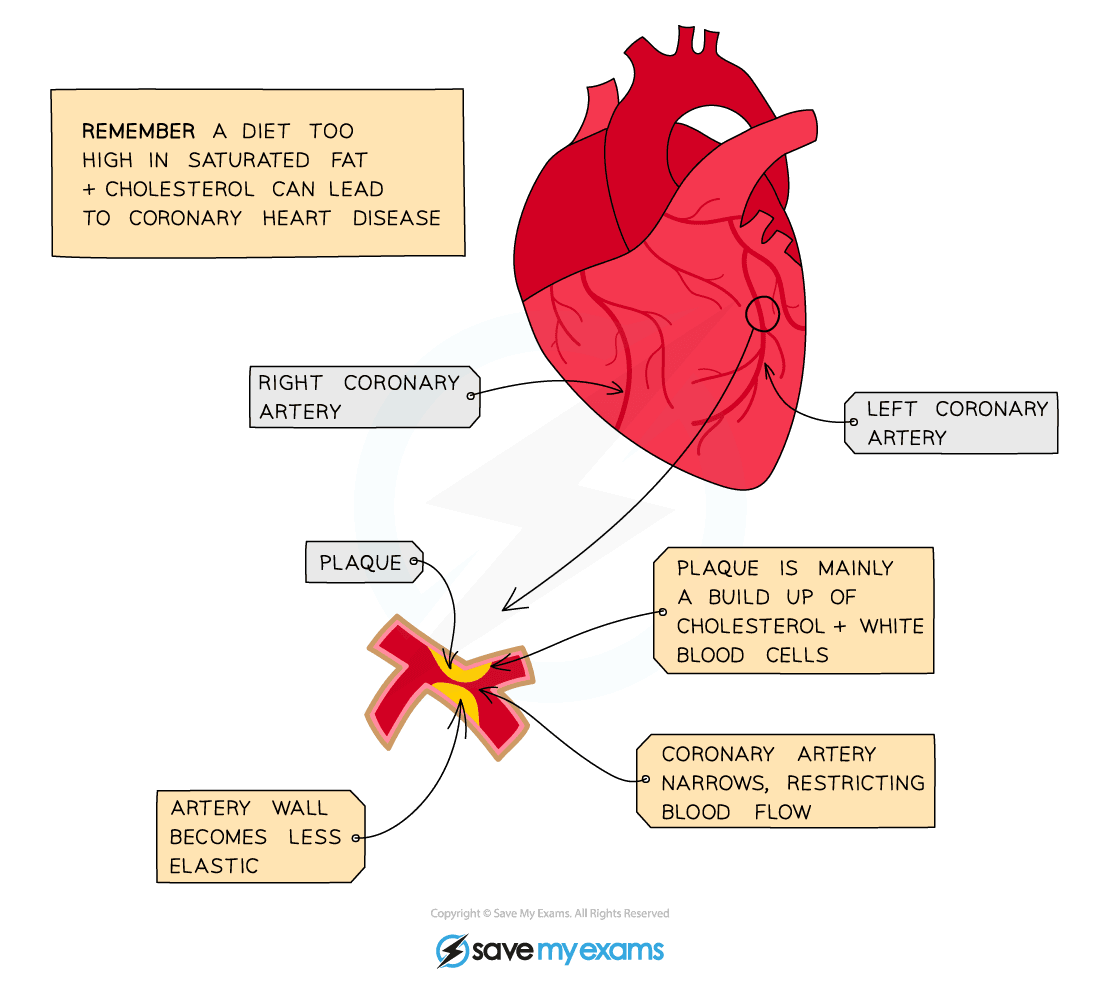Treating CVD
Types of CVD
- Cardiovascular disease includes any long term condition of the heart or blood vessels
- CVD usually occurs as a result of high cholesterol levels and the build-up of fatty deposits leading to the development of atherosclerosis
- There are several categories of CVD which include:
- Coronary heart disease – Angina, heart attacks and heart failure all disrupt the blood flow to the heart
- Strokes – Disruption of blood to the brain
- Peripheral arterial disease – Blockages to (peripheral) arteries in the limbs
- Aortic disease – Conditions associated with the aorta
Cholesterol
- There are two sources of cholesterol in the body:
- Dietary cholesterol (from animal products eaten)
- Cholesterol synthesised by the liver
- In coronary heart disease (CHD), cholesterol contributes to the build-up of fatty plaques inside the coronary arteries
- Fatty plaques reduce the flow of blood through the coronary arteries
- This is a problem because the cardiac muscle cells of the heart are supplied with blood by the coronary arteries that branch off directly from the aorta
- It is vital that this blood reaches these cells in order to supply oxygen for constant respiration
Build-up of plaque in the coronary arteries narrows the lumen
The effect of a narrowed lumen in a coronary artery is reduced blood flow to the heart
- If a coronary artery becomes partially or completely blocked by these fatty deposits, it loses its elasticity and cannot stretch to accommodate the blood which is being forced through every time the heart contracts
- This reduces the flow of blood through the arteries, resulting in a lack of oxygen for the heart muscle
- Partial blockage of the coronary arteries creates a restricted blood flow to the cardiac muscle cells and results in severe chest pains called angina
- Complete blockage means cells in that area of the heart will not be able to respire aerobically, leading to a heart attack
Treatment of CVD
- As cardiovascular diseases usually develop by the same mechanism, they can often be treated in similar ways, including:
- Surgical procedures
- Lifelong medication
- Lifestyle changes
Surgical Procedures
- Coronary bypass surgery involves replacing damaged vessels with healthy vessels from elsewhere in the body
- This allows blocked sections of the heart to be bypassed or replaced
- Heart transplants are a more complicated option to treat CVD
- Transplants carry the risk of rejection and the possibility that the heart will not work at all
- Patients would need to be on medication permanently
- More commonly, stents can be used to keep the coronary arteries open
- A narrow tube is threaded up through the groin up to the blocked vessel
- A tiny balloon is then inflated
- The balloon pushes the metal or plastic stent against the wall of the artery, increasing the width of the lumen
- The balloon and tube are then removed
Inserting a stent into a blocked artery is a relatively simple surgical procedure
- Stents are very effective at reducing the risk of a heart attack as they widen the lumen to increase blood flow to the coronary arteries, and the procedure is relatively simple
- Stents also last a long time, which is a positive, however, there is a risk of blood clots (thrombosis) occurring around
Treating CVD: Lifelong medication
- Aspirin is a drug which is commonly used for pain relief
- Low levels of aspirin can also be used to reduce CVD
- It works by inhibiting an enzyme associated with inflammation as well as blocking chemicals required in the formation of blood clots
- Anti-hypertensives can be used to reduce blood pressure
- This means less damage caused to arteries and so less build up of fatty plaques
- Statins are drugs that are widely used to reduce the levels of fatty deposits (cholesterol) in the blood
- They block an enzyme in the liver which is needed to make cholesterol
- This slows down the rate of fatty material building up in the blood, reducing the risk of CHD occurring
- There are many advantages and disadvantages of statins:
Statins Advantages & Disadvantages Table
Lifestyle changes
- Patients are encouraged to make lifestyle changes to reduce the risk of developing or worsening CVD
- Patients should:
- Stop smoking – to reduce the build-up of atherosclerosis
- Maintain a balanced diet including:
- Low cholesterol to reduce the build-up of atherosclerosis
- Low salt to reduce the risk of high blood pressure
- Controlled calories to maintain a healthy weight and reduce strain on the heart
- Increase exercise – to maintain a healthy weight and reduce strain on the heart





